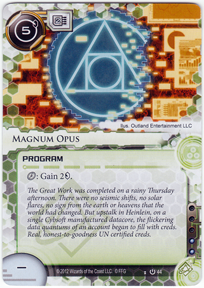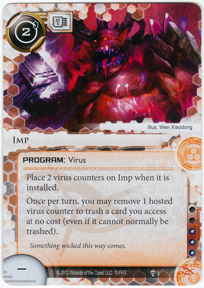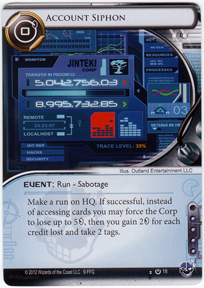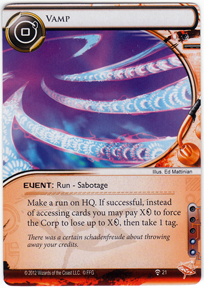Welcome to Card Game DB
Register now to gain access to all of our features. Once registered and logged in, you will be able to create topics, post replies to existing threads, give reputation to your fellow members, get your own private messenger, post status updates, manage your profile and so much more. If you already have an account, login here - otherwise create an account for free today!
Register now to gain access to all of our features. Once registered and logged in, you will be able to create topics, post replies to existing threads, give reputation to your fellow members, get your own private messenger, post status updates, manage your profile and so much more. If you already have an account, login here - otherwise create an account for free today!
Enter Subroutine - Lisbon league - part 2 (final)
Sep 24 2014 12:00 AM |
ashtaroth
in Android: Netrunner
Android: Netrunner ashtaroth enter subroutine The league is over. And I got a fairly good fourth place, considering my Runner part did nothing but lose.
The league is over. And I got a fairly good fourth place, considering my Runner part did nothing but lose.I played a couple more games, but there’s nothing interesting to write about them, so there goes a brief summary instead:
My Runner just lost. But fortunately I kept getting closer to victory. Kit is very aggressive and very fast, if you establish a good board presence in the early stages of the games she just dominates. Unfortunately she didn’t had that last punch, the one that really kills the game. It is evident that my list needs some tweaking, but since I wrote last article and until the end of the league I didn’t had proper time to evaluate my list flaws and build a better version of it. Will definitely do it now. Other than that, I felt pretty good even loosing. She’s very fun to play (really, really hard to pilot properly though). I did learn a lot, especially against Near Earth Hub and Replicating Perfection, which were 90% of this league’s meta.
The Corporation deck carried me all to way to the fourth place. It’s really a strong build. It loses a lot once players know what your deck is all about from the get-go, they’ll make dubious plays in order to pursue cards that outright block your strategy of Flatline and make you play a fairer game. So I’d recommend taking this deck to a bigger tournament and then shelve it for a couple of weeks.
For those who haven't seen the lists click here
Although my Runner deck didn’t perform as I’d liked, it was a good Test Run against NEH and RP archetypes which will be the focus of my article of today. So let’s analyze both these Corps:
Why are they good?
Both these Corporations play in a similar style, that being taxing the Runner so exhaustively that he/she’ll be rendered powerless. How do they achieve this? Through Asset economy and types of ICE that exhaust the Runner’s resources, more specifically, the Runner’s credits and thus their ability to act. These Assets also provide the Corporations with good resilience besides their already good Operations. But these two Corps distinguish on the way that they attack the Runner resources. For example, Near-Earth Hub normally plays Marked Accounts as a way to generate economy, its’ trash cost is 5 credits, the Runner can go directly at it, but by being free to rez, the Corp, in worst case scenario, will only trade a card for 6 virtual clicks (the click to run at the server and 5 credits). RP, which plays Sundew and Mental Health Clinic has fairly lower trash costs on its Assets, but the Identity is really good at protecting them, so for example, if the Runner wants to trash a Sundew he has to run at a central and if the Runner encounters a Tollbooth, the Sundew actual trash cost was 5 credits and two clicks, again the Corp doesn’t lose anything in this exchange.
They also have tools to deny the Runner possibilities of stealing Agendas: NEH incorporates a Fast Advance shell, importing Biotic Labor and going to the most famous city grid (Sansan) to score every agenda out of hand. Of course, it being a NBN identity it has access to the best Agenda in the game; other shells will go for a Tag’n’bag style, which is also another good plan to go with Asset-based economy.
RP relies in its upgrades and agendas to deny the Runner the chance of getting the agendas. Upgrades like Caprice Nisei and Ash are often used for this purpose and the agendas either protect themselves (The Future Perfect), or protect other agendas (Nisei MK II).
Because they have a really strong economy they can play really effective ICE, like Komainu, Tsurugi, Tollbooth in RP, or go with combotastic turns (Biotic Labor – rez SanSan – install and score a 4/2 agenda), and still maintain an hefty amount after all the rezzing, paying and advancing. This pressures the Runner as well, gives the game an inevitability atmosphere that the Runner must fight hard to combat.
Any weaknesses?
Yes! Many! What I’ve learn throughout this league is that, although pure economy cards for the Runner are, we could say, on level with the Corporations, the way both sides play don’t favor the Runner on the long haul. Since the Runner doesn’t have a way to make infinite drip economy like the Corporation it has to adjust its tools. These Corporations, however, depend heavily on their Assets and a consistent build up. If the Runner is able to deny the Corporation its build up, they can't force through, as their Operations aren't nearly as good nor in sufficient quantity. These Corporations, as any that wants to play horizontaly, put you in a decision of controlling the Remotes, or just prevent anything by locking up R&D, while the former is more click-consuming, the latter is riskier, because these deck will be ready for that and have tools to counter R&D lock. That said, it is still achievable nontheless and some well timed trashes, will prevent the Corps to be able to build-up.
So here’s my top strategies to go up against these two archetypes:
Go big, or go home!
If you decide to trash every Asset to deny them economy you have to be determined to really destroy each and every one, even if that means sacrificing 2 agenda points along the way. Because, if you trash 4 Assets, for example, Assets number 5 and 6 will make the Corp rich anyway, so you’ll be just wasting precious clicks. This strategy only works if you can apply it from the very beginning of the game and only if the Corp is still in its development phase. If the Corporation already has 15-20 credits due to its Operations, trashing all the economy Assets may be a liability.
On the other hand, you can opt to ignore the Assets entirely, but then focus on denying the Corporation the flow of the game. This works very well with an R&D lock, for example, or with a pressuring enough game that grants you multiple accesses. You'll then trash anything important you'll find along the way and try and deprive them the chance to build a secure enough server on top of R&D.
Against NEH-FA:
This seems to be the most common archetype and the most dangerous. Even if you destroy all their economy a well-timed rez of a Sansan City Grid and the Astrotrain sets off. You have to prioritize which Asset/Upgrade to attack.
Example 1: The Corporation is at nine credits, and has two installed cards (one is an Asset, the other is Sansan City Grid). In this case, although the Asset directly gives credits to the Corporation it might be more reasonable to go for the Sansan City Grid. However, if it is the first Sansan of the game, then it is more prudent to go after the Asset, even if that means that the Corp may spend 8 credits next turn to score out an agenda, but by doing this you’ll deplete the Corporation of its income and threatening power, after trashing Sansan. Because you go for the Asset in this example, you might even prevent the 2 point loss, as the Corp may withhold rezzing the Sansan, to not go broke over 2 agenda points.
Example 2: You’ve established an R&D lock and the Corporation is fairly poor, but because a NAPD, you’ve now given the chance for the Corporation to install some Assets (you accessed, but didn’t had the money to trash), should you go and start an Asset-denial strategy? In this situation I’d still focus on R&D, I can prepare to battle through a reinforced server, but there’s no reason to go after the Assets at this time, even if that means that the Corp will recover economically. Start to draw for answers if needed, keep your economy flow going and keep those draws under control. I should stress that, against NEH, you only really establish an R&D lock, if your runs are seeing 2 or more cards. Because of its drawing power, the R&D lock is harder to establish against this Corp.4
Against NEH – Tag’n’Bag:
This is easier to play around. Because I play Shapers I usually don’t have Plascrete Carapace in my decks, instead opting for a Magnum Opus economy, which grants me all the protection I need. Nevertheless, your biggest enemy here is Breaking News. You have to trash every Sansan to avoid a turn of Breaking News into two Scorched Earth. You might need a longer time to set up, to trash those Assets and still have enough to fend off a SEA Source, but this build is normally slower so you have more time to spend gathering money.
This Corporation normally doesn’t play very scary ICE, as they’re more interested in stopping you. Quandary, Caduceus, Eli 1.0, Wraparound, are common choices, normally Tollbooth being the meanest one. So standard breakers get the job done.
Against RP:
In this match-up, asset-control is harder to achieve because of the Corp’s nature. It’s still manageable though and as explained above, their Assets are not as costly as the ones NEH uses. Nevertheless and especially because of this (their trashing costs being lower), I prefer an extreme R&D lock against RP, you can trash their Assets along the way, just beware to keep at least four credits to pay for NAPD Contract. You can have a turn preparing the run and go for it on click three (which also, counters Enhanced Login Protocol). In this strategy you have to prioritize trashing Ash and/or Caprice, maybe even if sometimes you’ll let a NAPD Contract slide by. In the Asset denial strategy it’s best to take a whole turn to prepare and on the consequent turn go for 2-3 Assets. You can bluff a bad draw on the turn you are preparing, giving a false sense of relief to the Corporation. Expect common plays like an Eli 1.0 protecting a Sundew. Against Jinteki you have to decide from the get-go which path of attack you’re going to take. Know your deck well, to discern correctly which one is better. It’s much riskier to abandon one plan and go for another, since this Corp consumes you so much time.
Their meanest ICE is normally Tsurugi, Komainu, Tollbooth, which are all resolved pretty handily by Femme Fatale. But they’re effectively tougher to deal than the ICE NEH normally packs.
Either strategy you opt, or build your deck to execute you must 100% committed, there’s no second guessing, as that may enable the Corp to recover.
The Runner is well equipped to combat such strategies. Here's a list of what I feel are the best tools of the Runner to go up against these two strategies:
The best from the bunch – Magnum Opus

I sincerely feel this is the strongest card in the format right now. It might not be soon enough if stealth-breaking becomes a thing. But, for as long as Assets are prevalent, Magnum Opus will be the best to counter them. Trashing one, two, or more Assets per turn and recover almost immediately credit-wise is invaluable. Magnum Opus is also flexible enough to give the cash flow to advance your game state, building up to your final rig, granting you protection from SEA Source. For 5 credits, it’s a bargain.
The terminator – Imp

“Hasta la vista, baby!â€, Imp is a fantastic program that deals with those pesky Assets, while keeping your credit pool untouched. In faction you can make him have extra counters, and in Shapers, or with Shaper tools, you can re-buy him from the bin, for extra usage. Criminals do import him fairly easy as well, as they don’t have the absolute need to import cards as the other two factions have.
The librarian – Medium

Medium is fantastic in the strategy that you ignore the Assets and just concentrate on going for R&D. This is especially efficient against RP, since you can’t go directly to their remotes, just focusing on making big runs on R&D will reward you agenda points. If in a position to practice both strategies (asset-denial, controlling central servers), the Corp cannot Purge at will. If their economy is moderate (due to having to rez ICE and install them as a means to stop you from getting into R&D), you can quickly switch to an all Asset-denial strategy. Beware that this swap is as good as permanent. Doing a couple of turns denying them Assets, to then come back to R&D is a waste of time, and by then you have handed the game to the Corp.
The odd ball – Whizzard: Master Gamer

This Identity never had its time to shine, because the meta was not so Asset-based, but now it’s a good time to take him out and beat them asse(s)ts out of the Corps. Three recurring credits is a lot of money. In perspective, PAD Campaign costs 1 to trash, Marked Accounts 2, Sundew is free, Mental Health Clinic is free as well. Sansan is 2, Ash is free. It’s never-ending value. With all the tools Anarchs have at their disposal, a good Whizzard build, may help you to dominate the Corporation.
The bane of the living - Account Siphon

I have to make a reference to one of the most iconic Events of the game. In an Asset-denial strategy Account Siphon does it all in one card: robs the Corporation of the credits it earned through the Assets and gives you credits in enough quantity to trash said Assets. The drawback is real, beware of Closed Accounts, Bad Times, or even, Scorched Earth, but other than that, it doesn’t get better than this.
The child of the night – Vamp

Similar as Account Siphon, with the only exception that this card needs a strong economy behind it. Such as above stated Magnum Opus. The timing to play this card must be perfect, thus it’s less used as its Blue counterpart (which can be played more loosely), but do not underestimate a card that has the ability to turn the Corporation credit pool into a big fat, donut shaped zero. Along with Magnum Opus, this can serve as the killing blow, making you attack effectively not only their Asset-economy, but also any revenue they have amassed from Operations!
MOAB – Parasite

Bombing Pup, Quandary, Pop-up, Caduceus, Tsurugi, Komainu, Tollbooth, etc is extremely good! (the list of victims goes on) I’d always save a few card slots to run Parasite. It’s just that good right now. Of course, by definition Datasucker will help, but Datasucker is not as nearly as influential as it was a couple of months ago. Actually against NEH it might not do you a thing if all you’re running are remotes. The investment might be steep sometimes, but it’ll be worth it on the long haul. Parasite punishes both remote protection, granting you easier access to their remotes in order to trash Assets and centrals facilitating the R&D lock.
As I mentioned briefly, with the Stealth mechanics coming up, the meta might shift. If decks become more dependent of recurring credits to run, this makes your remaining credit pool wealthier to go after Assets/Upgrade, paying NAPD Contract and playing awesome Events.
That's all for this week. As usual, thank you for reading and feel free to write in the comments below what other strategies are you using to counter these two Corporations!
Until next time
Ashtaroth
- Jhaelen, scantrell24, NorthMaester and 3 others like this



 Sign In
Sign In Create Account
Create Account











0 Comments